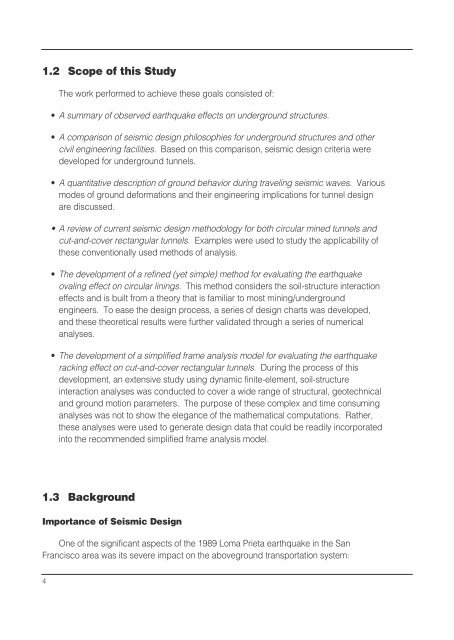Seismic Design of Tunnels - Parsons Brinckerhoff
Seismic Design of Tunnels - Parsons Brinckerhoff
Seismic Design of Tunnels - Parsons Brinckerhoff
You also want an ePaper? Increase the reach of your titles
YUMPU automatically turns print PDFs into web optimized ePapers that Google loves.
1.2 Scope <strong>of</strong> this Study<br />
The work performed to achieve these goals consisted <strong>of</strong>:<br />
• A summary <strong>of</strong> observed earthquake effects on underground structures.<br />
• A comparison <strong>of</strong> seismic design philosophies for underground structures and other<br />
civil engineering facilities. Based on this comparison, seismic design criteria were<br />
developed for underground tunnels.<br />
• A quantitative description <strong>of</strong> ground behavior during traveling seismic waves. Various<br />
modes <strong>of</strong> ground deformations and their engineering implications for tunnel design<br />
are discussed.<br />
• A review <strong>of</strong> current seismic design methodology for both circular mined tunnels and<br />
cut-and-cover rectangular tunnels. Examples were used to study the applicability <strong>of</strong><br />
these conventionally used methods <strong>of</strong> analysis.<br />
• The development <strong>of</strong> a refined (yet simple) method for evaluating the earthquake<br />
ovaling effect on circular linings. This method considers the soil-structure interaction<br />
effects and is built from a theory that is familiar to most mining/underground<br />
engineers. To ease the design process, a series <strong>of</strong> design charts was developed,<br />
and these theoretical results were further validated through a series <strong>of</strong> numerical<br />
analyses.<br />
• The development <strong>of</strong> a simplified frame analysis model for evaluating the earthquake<br />
racking effect on cut-and-cover rectangular tunnels. During the process <strong>of</strong> this<br />
development, an extensive study using dynamic finite-element, soil-structure<br />
interaction analyses was conducted to cover a wide range <strong>of</strong> structural, geotechnical<br />
and ground motion parameters. The purpose <strong>of</strong> these complex and time consuming<br />
analyses was not to show the elegance <strong>of</strong> the mathematical computations. Rather,<br />
these analyses were used to generate design data that could be readily incorporated<br />
into the recommended simplified frame analysis model.<br />
1.3 Background<br />
Importance <strong>of</strong> <strong>Seismic</strong> <strong>Design</strong><br />
One <strong>of</strong> the significant aspects <strong>of</strong> the 1989 Loma Prieta earthquake in the San<br />
Francisco area was its severe impact on the aboveground transportation system:<br />
4
















